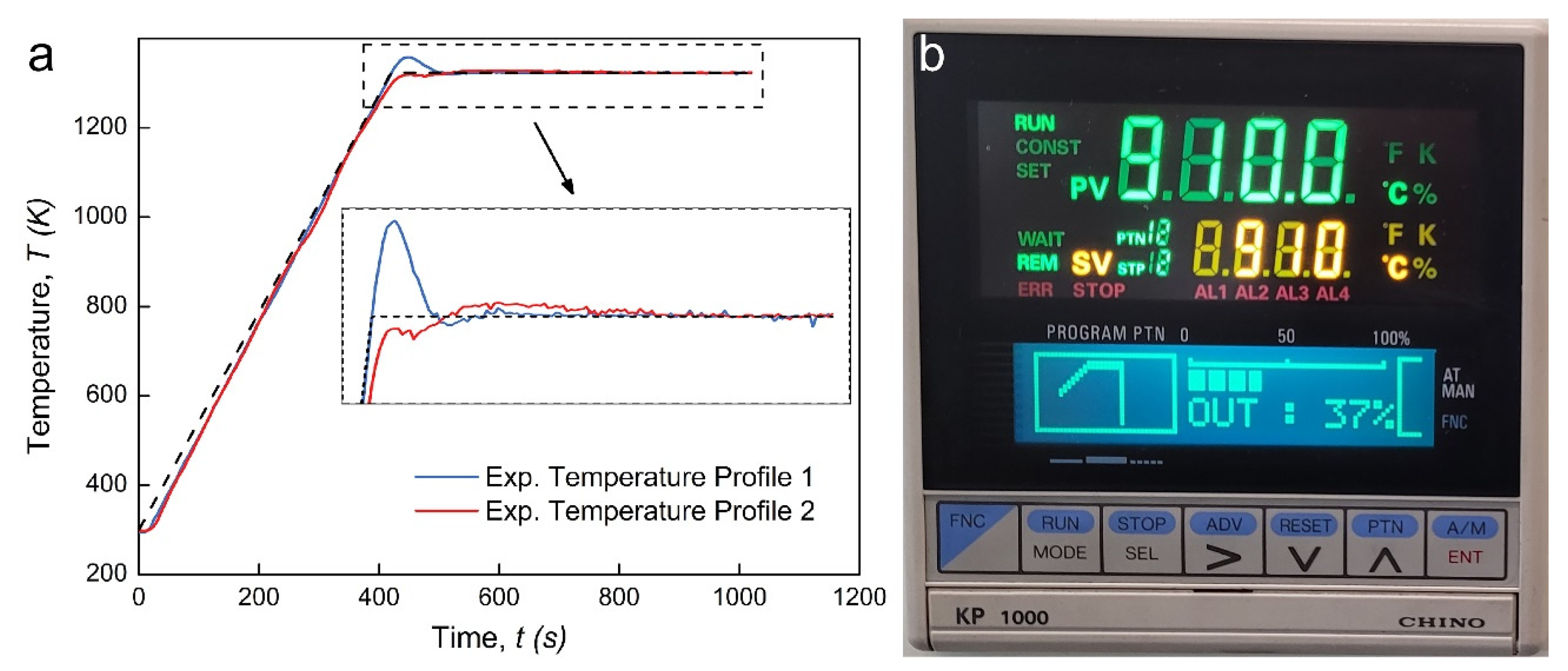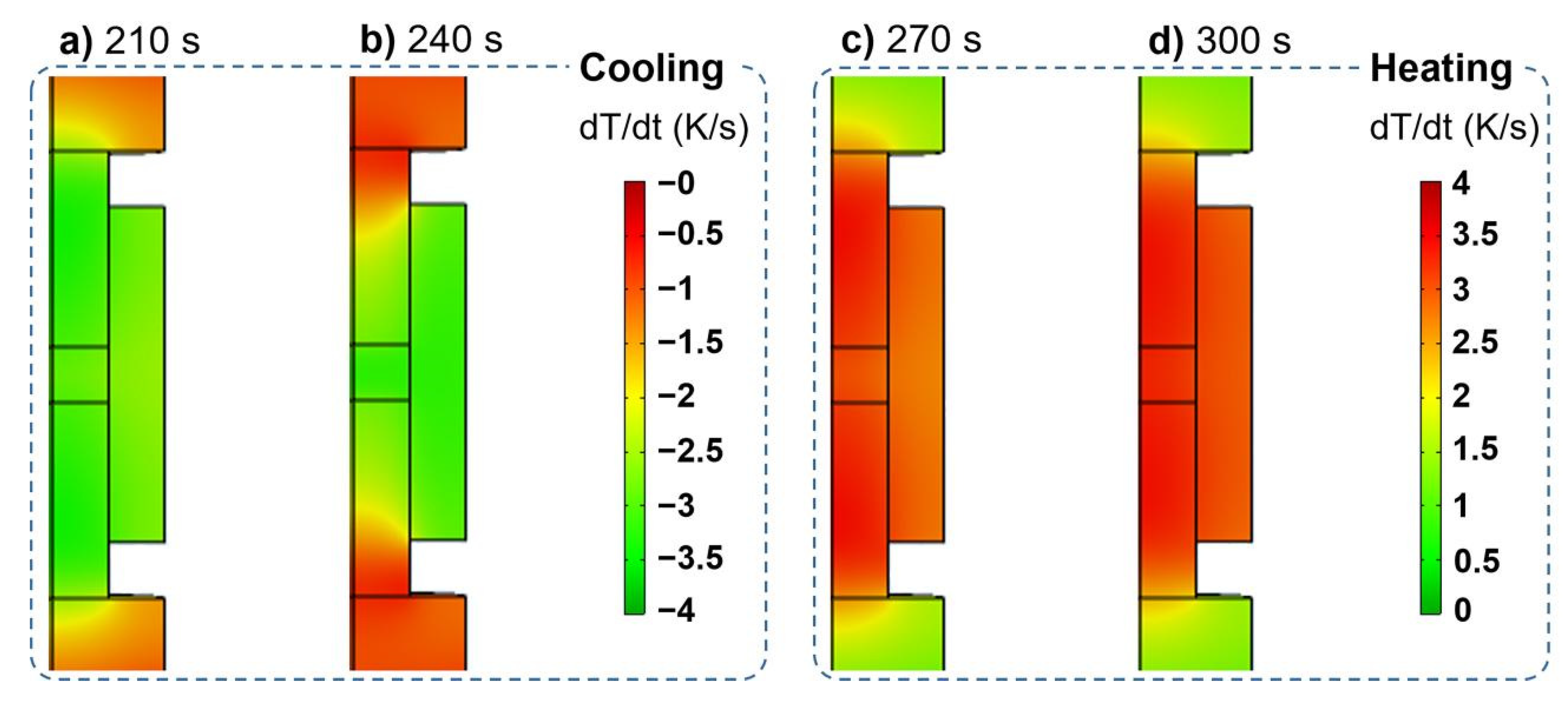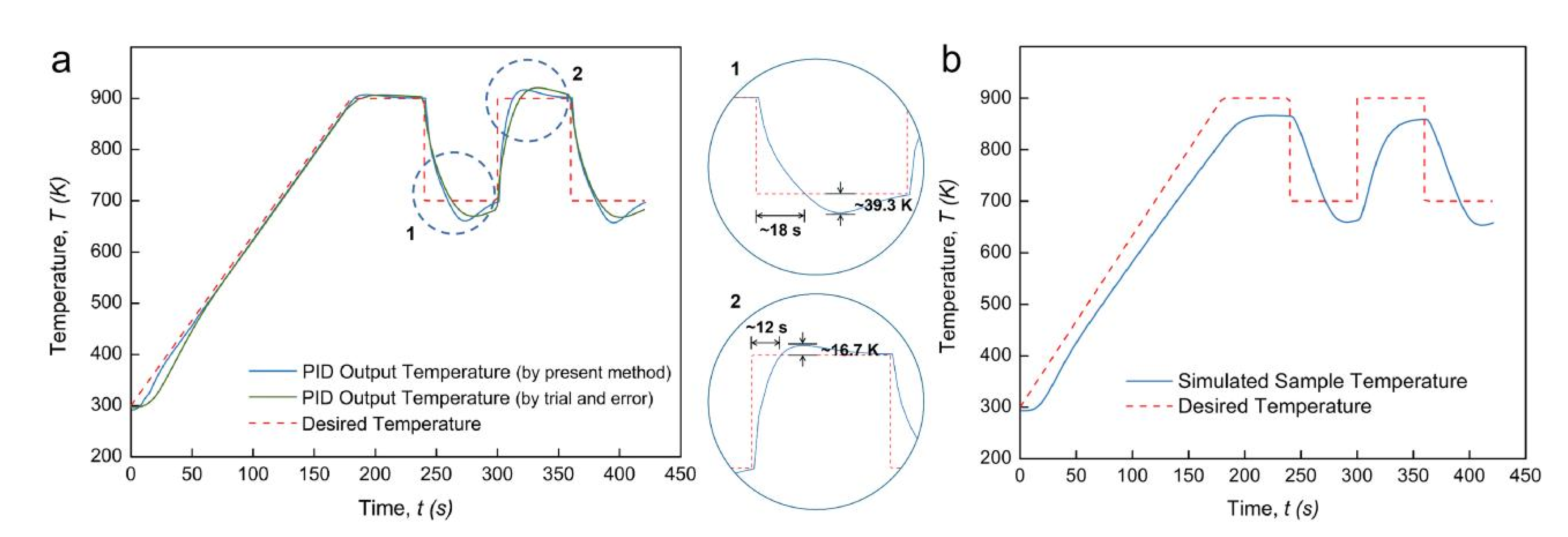Proportional Integral Derivative Control in Spark Plasma Sintering Simulations
Abstract
:1. Introduction
2. Methods
2.1. Algorithm for Determination of PID Coefficients
2.2. Construction of PID Controller for Desired Temperature Profiles
2.3. Criterion for Temperature Profile Fitting
2.4. Configuration of Die–Sample Setup in SPS Simulation
3. Results and Discussion
3.1. Temperature Regulation in the SPS Devices
3.2. Regular Temperature Profile with Isothermal Insulation
3.3. Continuous Temperature Profile with Cyclic Temperature Oscillation
3.4. Non-Continuous Temperature Profile with Sudden Temperature Change
3.5. Limitations of the Developed Numerical Method for Construction of PID Coefficients
4. Conclusions
Author Contributions
Funding
Institutional Review Board Statement
Informed Consent Statement
Data Availability Statement
Conflicts of Interest
References
- Risbud, S.H.; Han, Y.H. Preface and historical perspective on spark plasma sintering. Scr. Mater. 2013, 69, 105–106. [Google Scholar] [CrossRef]
- Munir, Z.A.; Tamburini, U.; Ohyanagi, M. The effect of electric field and pressure on the synthesis and consolidation of materials: A review of the spark plasma sintering method. J. Mater. Sci. 2006, 41, 763–777. [Google Scholar] [CrossRef]
- Azarniya, A.; Azarniya, A.; Sovizi, S.; Hosseini, H.R.M.; Varol, T.; Kawasaki, A.; Ramakrishna, S. Physicomechanical properties of spark plasma sintered carbon nanotube-reinforced metal matrix nanocomposites. Prog. Mater. Sci. 2017, 90, 276–324. [Google Scholar] [CrossRef]
- Olevsky, E.; Dudina, D.V. Field Assisted Sintering: Science and Application, 1st ed.; Springer: Cham, Switzerland, 2018. [Google Scholar]
- Orrù, R.; Licheri, R.; Locci, A.M.; Cincotti, A.; Cao, G. Consolidation/synthesis of materials by electric current activated/assisted sintering. Mater. Sci. Eng. R 2009, 63, 127–287. [Google Scholar] [CrossRef]
- Zhou, Y.F.; Zhao, Z.Y.; Tan, X.Y.; Luo, L.M.; Xu, Y.; Zan, X.; Xu, Q.; Tokunaga, K.; Zhu, X.Y.; Wu, Y.C. Densification and microstructure evolution of W-TiC-Y2O3 during spark plasma sintering. Int. J. Refract. Met. Hard Mater. 2019, 79, 95–101. [Google Scholar] [CrossRef]
- Chawake, N.; Raman, L.; Ramasamy, P.; Ghosh, P.; Spieckermann, F.; Gammer, C.; Murty, B.S.; Kottada, R.S.; Eckert, J. Composite of medium entropy alloys synthesized using spark plasma sintering. Scr. Mater. 2021, 191, 46–51. [Google Scholar] [CrossRef]
- Larimian, T.; Chaudhary, V.; Christudasjustus, J.; Ramanujan, R.V.; Gupta, R.; Borkar, T. Bulk-nano spark plasma sintered Fe-Si-B-Cu-Nb based magnetic alloys. Intermetallics 2020, 124, 106869. [Google Scholar] [CrossRef]
- Pavia, A.; Durand, L.; Ajustron, F.; Bley, V.; Chevallier, G.; Peigney, A.; Estournès, C. Electro-thermal measurements and finite element method simulations of a spark plasma sintering device. J. Mater. Process. Technol. 2013, 213, 1327–1336. [Google Scholar] [CrossRef] [Green Version]
- Achenani, Y.; Saâdaoui, M.; Cheddadi, A.; Bonnefont, G.; Fantozzi, G. Finite element modeling of spark plasma sintering: Application to the reduction of temperature inhomogeneities, case of alumina. Mater. Des. 2017, 116, 504–514. [Google Scholar] [CrossRef]
- Byon, C.; Li, M.H.; Kakegawa, K.; Han, Y.H.; Lee, D.Y. Numerical study of a SiC mould subjected to a spark plasma sintering process. Scr. Mater. 2015, 96, 49–52. [Google Scholar] [CrossRef]
- Schwertz, M.; Katz, A.; Sorrel, E.; Lemonnier, S.; Barraud, E.; Carradò, A.; d’Astorg, S.; Leriche, A.; Nardin, M.; Vallat, M.F.; et al. Coupled electro-thermo-mechanical finite element modeling of the spark plasma sintering technique. Metall. Mater. Trans. B 2016, 47, 1263–1273. [Google Scholar] [CrossRef]
- Diatta, J.; Antou, G.; Pradeilles, N.; Maître, A. Numerical modeling of spark plasma sintering-Discussion on densification mechanism identification and generated porosity gradients. J. Eur. Ceram. Soc. 2017, 37, 4849–4860. [Google Scholar] [CrossRef]
- Sakkaki, M.; Moghanlou, F.S.; Vajdi, M.; Asl, M.S.; Mohammadi, M.; Shokouhimehr, M. Numerical simulation of heat transfer during spark plasma sintering of zirconium diboride. Ceram. Int. 2020, 46, 4998–5007. [Google Scholar] [CrossRef]
- Hu, Z.Y.; Zhang, Z.H.; Cheng, X.W.; Wang, F.C.; Zhang, Y.F.; Li, S.L. A review of multi-physical fields induced phenomena and effects in spark plasma sintering: Fundamentals and applications. Mater. Des. 2020, 191, 108662. [Google Scholar] [CrossRef]
- Manière, C.; Lee, G.; Olevsky, E.A. Proportional integral derivative, modeling and ways of stabilization for the spark plasma sintering process. Results Phys. 2017, 7, 1494–1497. [Google Scholar] [CrossRef]
- Bennett, S. Development of PID controllers. IEEE Control Syst. Mag. 1993, 13, 58–62. [Google Scholar] [CrossRef]
- Van der Laan, A.; Boyer, V.; Epherre, R.; Estournès, C. Simple method for the identification of electrical and thermal contact resistances in spark plasma sintering. J. Eur. Ceram. Soc. 2021, 41, 599–610. [Google Scholar] [CrossRef]
- Manière, C.; Pavia, A.; Durand, L.; Chevallier, G.; Afanga, K.; Estournès, C. Finite-element modeling of the electro-thermal contacts in the spark plasma sintering process. J. Eur. Ceram. Soc. 2016, 36, 741–748. [Google Scholar] [CrossRef] [Green Version]
- Wei, X.; Giuntini, D.; Maximenko, A.L.; Haines, C.D.; Olevsky, E.A. Experimental Investigation of Electric Contact Resistance in Spark Plasma Sintering Tooling Setup. J. Am. Ceram. Soc. 2015, 98, 3553–3560. [Google Scholar] [CrossRef]
- Lee, G.; Olevsky, E.A.; Maniere, C.; Maximenko, A.; Izhvanov, O.; Back, C.; McKittrick, J. Effect of electric current on densification behavior of conductive ceramic powders consolidated by spark plasma sintering. Acta Mater. 2018, 144, 524–533. [Google Scholar] [CrossRef]
- Manière, C.; Durand, L.; Brisson, E.; Desplats, H.; Carré, P.; Rogeon, P.; Estournès, C. Contact resistances in spark plasma sintering: From in-situ and ex-situ determinations to an extended model for the scale up of the process. J. Eur. Ceram. Soc. 2017, 37, 1593–1605. [Google Scholar] [CrossRef] [Green Version]
- Schuh, C.A.; Dunand, D.C. Enhanced densification of zinc powders through thermal cycling. Acta Mater. 2002, 50, 1349–1358. [Google Scholar] [CrossRef]
- Madhav Reddy, K.; Kumar, N.; Basu, B. Innovative multi-stage spark plasma sintering to obtain strong and tough ultrafine-grained ceramics. Scr. Mater. 2010, 62, 435–438. [Google Scholar] [CrossRef]
- Madhav Reddy, K.; Kumar, N.; Basu, B. Inhibition of grain growth during the final stage of multi-stage spark plasma sintering of oxide ceramics. Scr. Mater. 2010, 63, 585–588. [Google Scholar] [CrossRef]
- Podlubny, I. Fractional-order systems and PIλDµ controllers. IEEE Trans. Autom. Control 1999, 44, 208–214. [Google Scholar] [CrossRef]
- Abdulwahhab, O.W. Design of a complex fractional order PID controller for a first order plus time delay system. ISA Trans. 2020, 99, 154–158. [Google Scholar] [CrossRef]
- Padula, F.; Visioli, A. Optimal tuning rules for proportional-integral-derivative and fractional-order proportional-integral-derivative controllers for integral and unstable processes. IET Control Theory Appl. 2012, 6, 776–786. [Google Scholar] [CrossRef]







| Material | Heat Capacity, Cp (J·Kg−1·K−1) | Thermal Conductivity, κ (W·m−1·K−1) | Electrical Resistivity, ρe (Ω·m) | Density, ρ (kg·m−3) |
|---|---|---|---|---|
| Graphite | 34.27 + 2.72T − 9.6 × 10−4T2 | 123 − 6.99 × 10−2T + 1.55 × 10−5T2 | 1.70 × 10−5 − 1.87 × 10−8T + 1.26 × 10−11T2 − 2.44 × 10−15T3 | 1904 − 0.0141T |
| Electrode | 446.5 + 0.162T | 9.99 + 0.0175T | (50.2 + 0.0838T − 1.76 × 10−5T2) × 10−8 | 7900 |
| TiAl | 583 + 9.40 × 10−2T | 9.47 + 1.19 × 10−2T | 4.06 × 10−7 + 6.45 × 10−10T | 3900 |
Publisher’s Note: MDPI stays neutral with regard to jurisdictional claims in published maps and institutional affiliations. |
© 2021 by the authors. Licensee MDPI, Basel, Switzerland. This article is an open access article distributed under the terms and conditions of the Creative Commons Attribution (CC BY) license (https://creativecommons.org/licenses/by/4.0/).
Share and Cite
Jiang, R.; Torresani, E.; Cui, G.; Olevsky, E.A. Proportional Integral Derivative Control in Spark Plasma Sintering Simulations. Materials 2021, 14, 1779. https://doi.org/10.3390/ma14071779
Jiang R, Torresani E, Cui G, Olevsky EA. Proportional Integral Derivative Control in Spark Plasma Sintering Simulations. Materials. 2021; 14(7):1779. https://doi.org/10.3390/ma14071779
Chicago/Turabian StyleJiang, Runjian, Elisa Torresani, Guodong Cui, and Eugene A. Olevsky. 2021. "Proportional Integral Derivative Control in Spark Plasma Sintering Simulations" Materials 14, no. 7: 1779. https://doi.org/10.3390/ma14071779







